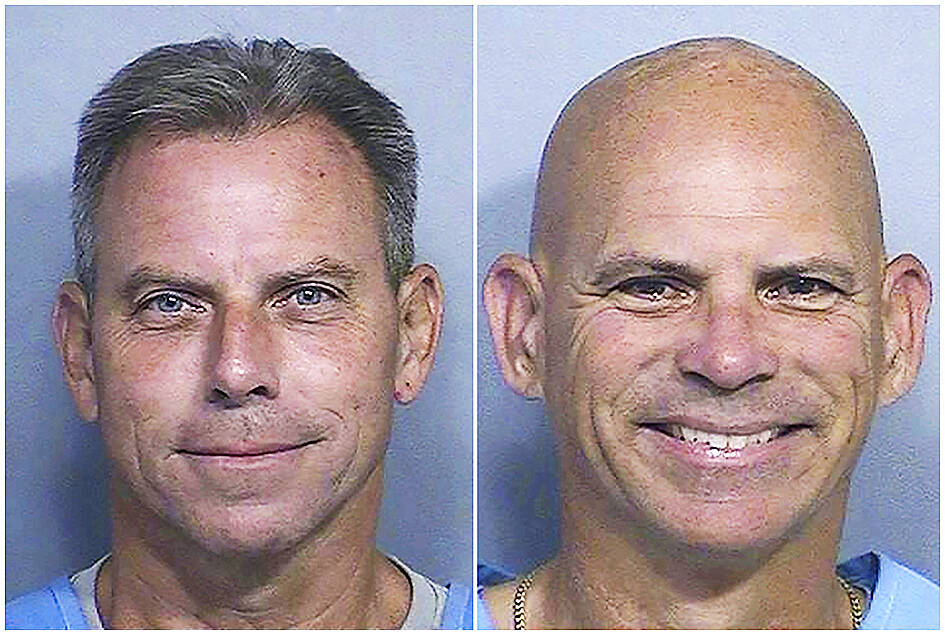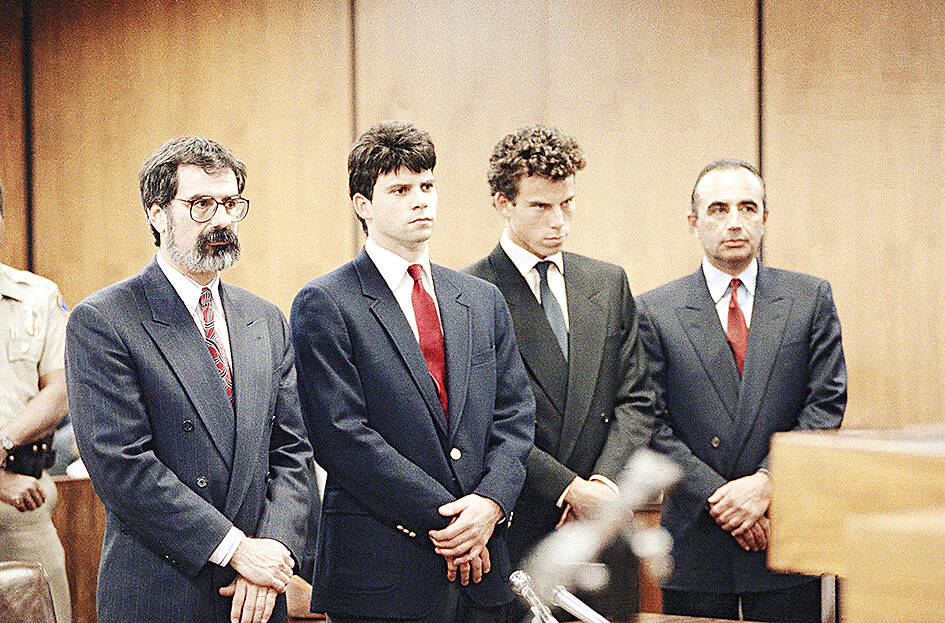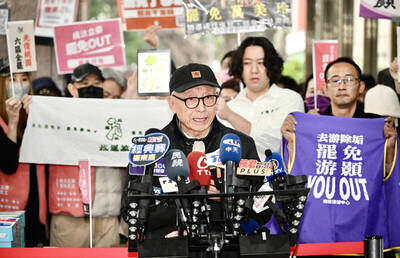In 1989, Americans were riveted by the shotgun murders of Jose and Kitty Menendez in their Beverly Hills mansion by their own children. Lyle and Erik Menendez were sentenced to life in prison and lost all subsequent appeals. But today, more than three decades later, they unexpectedly have a chance of getting out.
Not because of the workings of the legal system. Because of entertainment.
After two recent documentaries and a scripted drama on the pair brought new attention to the 35-year-old case, the Los Angeles district attorney has recommended they be resentenced.

Photo: AP
The popularity and proliferation of true crime entertainment like Netflix’s docudrama Monsters: The Lyle and Erik Menendez Story is effecting real life changes for their subjects and in society more broadly. At their best, true crime podcasts, streaming series and social media content can help expose injustices and right wrongs.
But because many of these products prioritize entertainment and profit, they also can have serious negative consequences.
MENEDEZ BROTHERS

Photo: AP
The use of true crime stories to sell a product has a long history in America, from the tabloid “penny press” papers of the mid-1800s to television movies like 1984’s The Burning Bed. These days it’s podcasts, bingeable Netflix series and even true crime TikToks. The fascination with the genre may be considered morbid by some, but it can be partially explained by the human desire to make sense of the world through stories.
In the case of the Menendez brothers, Lyle, who was then 21, and Erik, then 18, have said they feared their parents were about to kill them to prevent the disclosure of the father’s long-term sexual molestation of Erik. But at their trial, many of the sex abuse allegations were not allowed to be presented to the jury, and prosecutors contended they committed murder simply to get at their parents’ money.
For years, that’s the story that many people who watched the saga from a distance accepted and talked about.
The new dramas delve into the brothers’ childhood, helping the public better understand the context of the crime and thus see the world as a less frightening place, says Adam Banner, a criminal defense attorney who writes a column on pop culture and the law for the American Bar Association’s ABA Journal.
“Not only does that make us feel better intrinsically,” Banner says, “but it also objectively gives us the ability to think, ‘Well, now I can take this case and put it in a different bucket than another situation where I have no explanation and the only thing I can say is, ‘This child just must be evil.’”
RISE OF ANTIHERO
Much true crime of the past takes particularly shocking crimes and explores them in depth, generally with the assumption that those convicted of the crime were actually guilty and deserved to be punished.
The success of the podcast Serial, which cast doubt on the murder conviction of Adnan Syed, has given birth to a newer genre that often assumes (and intends to prove) the opposite. The protagonists are innocent, or — as in the case of the Menendez brothers — guilty but sympathetic, and thus not deserving of their harsh sentences.
“There is an old tradition of journalists picking apart criminal cases and showing that people are potentially innocent,” says Maurice Chammah, a staff writer at The Marshall Project and author of Let the Lord Sort Them: The Rise and Fall of the Death Penalty.
“But I think that the curve kind of goes up exponentially in the wake of Serial, which was 2014 and obviously changed the entire landscape economically and culturally of podcasts,” Chammah says. “And then you have Making a Murderer come along a few years later and become a kind of behemoth example of that in docuseries.”
Roughly during the same time period, the innocence movement gained traction along with the Black Lives Matter movement and greater attention on police custody deaths. And in popular culture, both fiction and nonfiction, the trend is to mine a villainous character’s backstory.
“All these superheroes, supervillains, the movie Joker — you’re just inundated with this idea that people’s bad behavior is shaped by trauma when they were younger,” Chammah said.
Banner often represents some of the least sympathetic defendants imaginable, including those accused of child sexual abuse. He says the effects of these cultural trends are real. Juries today are more likely to give his clients the benefit of the doubt and are more skeptical of police and prosecutors. But he also worries about the intense focus in current true crime on cases where things went wrong, which he says are the outliers.
While the puzzle aspect of “Did they get it right?” might feed our curiosity, he says, we run the risk of sowing distrust in the entire criminal justice system.
“You don’t want to take away the positive ramifications that putting that spotlight on a case can bring. But you also don’t want to give off the impression that this is how our justice system works. That if we can get enough cameras and microphones on a case, then that’s how we’re going to save somebody off of death row or that’s how we’re going to get a life sentence overturned.”
Adds Chammah: “If you open up sentencing decisions and second looks and criminal justice policy to pop culture — in the sense of who gets a podcast made about them, who gets Kim Kardashian talking about them — the risk of extreme arbitrariness is really great. ... It feels like it’s only a matter of time before the wealthy family of some defendant basically funds a podcast that tries to make a viral case for their innocence.”
AUDIENCE FACTOR
Whitney Phillips, who teaches a class on true crime and media ethics at the University of Oregon, says the popularity of the genre on social media adds another layer of complications, often encouraging active participation of viewer and listeners.
“Because these are not trained detectives or people who have any actual subject area expertise in forensics or even criminal law, then there’s this really common outcome of the wrong people being implicated or floated as suspects,” she says. “Also, the victims’ families now are part of the discourse. They might be accused of this, that, or the other, or at the very least, you have your loved one’s murder, violent death, being entertainment for millions of strangers.”
This sensibility has been both chronicled and lampooned in the streaming comedy-drama series Only Murders in the Building, which follows three unlikely collaborators who live in a New York apartment building where a murder has taken place. The trio decide to make a true crime podcast while simultaneously trying to solve the case.
Nothing about true crime is fundamentally unethical, Phillips says. “It’s that the social media system — the attention economy — is not calibrated for ethics. It’s calibrated for views, it’s calibrated for engagement and it’s calibrated for sensationalism.”
Many influencers are now vying for the “murder audience,” Phillips says, with social media and more traditional media feeding off each other. True crime is now creeping into lifestyle content and even makeup tutorials.
“It was sort of inevitable that you would see the collision of these two things and having these influencers literally just put on a face of makeup and then tell a very kind of — it’s very informal, it’s very dishy, it’s often not particularly well researched,” she says. “This is not investigative journalism.”

The Democratic Progressive Party (DPP), Chinese Nationalist Party (KMT), and the country’s other political groups dare not offend religious groups, says Chen Lih-ming (陳立民), founder of the Taiwan Anti-Religion Alliance (台灣反宗教者聯盟). “It’s the same in other democracies, of course, but because political struggles in Taiwan are extraordinarily fierce, you’ll see candidates visiting several temples each day ahead of elections. That adds impetus to religion here,” says the retired college lecturer. In Japan’s most recent election, the Liberal Democratic Party lost many votes because of its ties to the Unification Church (“the Moonies”). Chen contrasts the progress made by anti-religion movements in

Taiwan doesn’t have a lot of railways, but its network has plenty of history. The government-owned entity that last year became the Taiwan Railway Corp (TRC) has been operating trains since 1891. During the 1895-1945 period of Japanese rule, the colonial government made huge investments in rail infrastructure. The northern port city of Keelung was connected to Kaohsiung in the south. New lines appeared in Pingtung, Yilan and the Hualien-Taitung region. Railway enthusiasts exploring Taiwan will find plenty to amuse themselves. Taipei will soon gain its second rail-themed museum. Elsewhere there’s a number of endearing branch lines and rolling-stock collections, some

Last week the State Department made several small changes to its Web information on Taiwan. First, it removed a statement saying that the US “does not support Taiwan independence.” The current statement now reads: “We oppose any unilateral changes to the status quo from either side. We expect cross-strait differences to be resolved by peaceful means, free from coercion, in a manner acceptable to the people on both sides of the Strait.” In 2022 the administration of Joe Biden also removed that verbiage, but after a month of pressure from the People’s Republic of China (PRC), reinstated it. The American

This was not supposed to be an election year. The local media is billing it as the “2025 great recall era” (2025大罷免時代) or the “2025 great recall wave” (2025大罷免潮), with many now just shortening it to “great recall.” As of this writing the number of campaigns that have submitted the requisite one percent of eligible voters signatures in legislative districts is 51 — 35 targeting Chinese Nationalist Party (KMT) caucus lawmakers and 16 targeting Democratic Progressive Party (DPP) lawmakers. The pan-green side has more as they started earlier. Many recall campaigns are billing themselves as “Winter Bluebirds” after the “Bluebird Action”